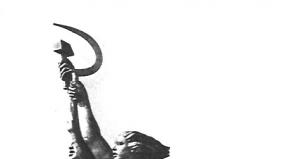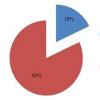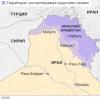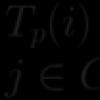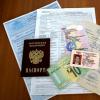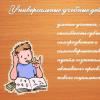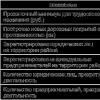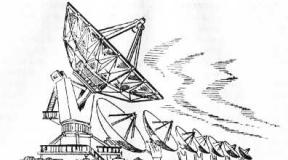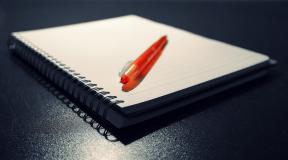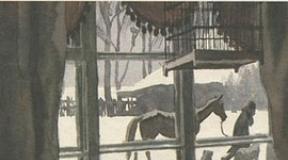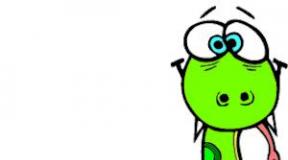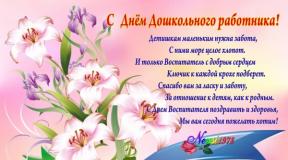Productive activity of preschool children. Methods and techniques of teaching productive activities of preschool children Planning methods and forms of organizing productive activities
Productive activity in preschool education is the activity of children under the guidance of an adult, as a result of which a certain product appears.
Productive activities include:
- - design,
- - Painting,
- - modeling,
- - application,
- - theatrical activities, etc.
In productive activities, intellectual and affective processes are closely intertwined.
In the process of productive activity, such important personality traits as activity, independence, initiative are formed, which are the main components of creative activity. The child learns to be active in observing, performing work, to show independence and initiative in thinking over the content, selecting materials, using a variety of means of artistic expression. It is no less important to foster purposefulness in work, the ability to bring it to the end.
As Galina Anatolyevna Uruntaeva noted, the productive activity of a preschooler, modeling objects of the surrounding world, leads to the creation of a real product, in which the idea of an object, phenomenon, situation is materially embodied in a drawing, structure, three-dimensional image. According to Galina Anatolyevna Uruntaeva, mastering this activity, the child learns to highlight in a real object those aspects that can be reflected in one form or another.
Constructive activity, visual, play have a modeling character, because productive activity leads to the creation of a real product, in which the idea of an object, phenomenon, situation is materially embodied in a drawing, structure, three-dimensional image.
Design is a purposeful process of creating a certain result. In preschool age, these are usually buildings from bricks or all kinds of constructors. Constructive activity requires its own methods and techniques, that is, special operational and technical means. In the process of designing, the child learns to correlate the size and shape of various parts, finds out their constructive properties.
There are the following three types of constructive activity of the child.
The first and most elementary is model design. The child is shown a model of a future building or shown how to build, and asked to reproduce a given model. Such activity does not require special mental and creative stress, but it requires attention, concentration, and most importantly - the acceptance of the very task of "acting according to the model."
The second type is Conditional Design. In this case, the child begins to build his structure not on the basis of a model, but on the basis of conditions that are put forward by the tasks of the game or by the adult. For example, a child needs to build and fence two houses - one for the geese and one for the fox. When performing this task, he must comply with at least two conditions: first, the fox's house must be larger, and secondly, the goose house must be surrounded by a high fence so that the fox does not penetrate into it.
The third type of constructive activity is design by design. Here, nothing limits the imagination of the child and the building material itself. This type of construction is usually required by the game: here you can build not only from special building material, but also from any surrounding objects: furniture, sticks, umbrellas, pieces of fabric, etc.
All these types of design are not stages that successively replace each other. They coexist and intersperse each other depending on the task and situation. But each of them develops certain abilities.
The fundamental point in the design is the analytical and synthetic activity for the examination of objects, which makes it possible to establish the structure of an object and its parts, to take into account the logic of their connection. As noted by Ya.L. Kolomensky and E.A. Panko, children's experimentation in the field of constructive activity is also an important means of developing thinking.
According to Galiguzova Lyudmila Nikolaevna, from the first year of life, design elements can be introduced into a child's play, developing visual-figurative thinking, perception, the ability to correlate the shapes of objects, fine motor skills of the fingers. Bulycheva A. notes the need for an interest in activity, the presence of motivation, a positive attitude to cognition, cognitive interest in the surrounding reality, the presence of motivation, manifested in preschool age, guided by a cognitive task, while Nikolai Nikolayevich Poddyakov sees the need for organization to achieve these conditions " children's experimentation ”, observation of various patterns encourages children to be interested in the discovery of the patterns themselves, to find the common in specific manifestations.
Modeling allows you to depict objects in three-dimensional space. During sculpting, the child can convey the shape of a person, animals, birds, fruits, dishes, etc. It is valuable that the properties of the materials used in sculpting make it possible to repeatedly change the shape, reaching the desired expressiveness. It is the development of the ability to convey the expressiveness of the image in sculpting that special attention should be paid in working with children entering school.
It is important that the child knows how to sculpt not just a human figure, but a person of a certain age, heroes of a particular fairy tale - Dunno, Cheburashka, etc. He must be able to convey the movements of a person, animals, reflecting the nature of images and the dynamics of actions.
While doing applique work, children learn to cut various plots, patterns, ornaments out of paper, and stick them on a colored background. Children perform both individual and collective work. Children learn to be accurate, assiduous, master the basic techniques of cutting, the rules for working with glue.
Drawing is popular among preschoolers 5-6.5 years old. By drawing, the child expresses his desire for knowledge of the world around him, and by drawing, to a certain extent, one can find out the level of this knowledge. The more developed children's perception, observation, the wider the stock of their ideas, the more fully and more accurately they reflect reality in their work, the richer and more expressive their drawings. The visual activity of 6-year-old children reflects such specific features of their thinking as concreteness, imagery. The graphic activity of the child is closely connected not only with individual functions (perception, memory, thinking, imagination), but also with the personality as a whole. It shows the interests of the child, temperament, some gender differences.
The Italian psychologist C. Ricci identifies two stages in the evolution of children's drawing: to the pictorial and pictorial. The stages, in turn, are divided into several stages.
The first stage before the pictorial stage is the scribble stage, which begins at the age of two. The first scribbles are usually almost random marks. At this time, the child is not interested in the image, but in the pencil itself. Moreover, the child may not look at the pencil at all when drawing with it on paper. At this stage, he still does not know how to associate visual images with drawing. He enjoys the very movements of the pencil hand. During this period, the child is not yet able to draw something real, so it is simply impossible to teach him at this age to draw, for example, an apple. Approximately 6 months after the beginning of the scribble stage, the child has the opportunity to visualize drawing. Now he knows visually what he is doing. Most children paint with great enthusiasm during this period. Any remarks that discourage a child from drawing at this stage can cause a delay in his general development, since this type of control is important for other areas of activity.
The karakul stage lasts in different ways, sometimes it passes quickly enough, but always at this time the child looks for and masters three lines: horizontal, vertical, learns to close the circle. He learns to navigate on a piece of paper and a special problem at this time is to stop. The child has to specially master this skill: not to lead an endless horizontal line, from the kitchen to the front door along the wall, across the entire corridor, but to stop his hand in time. The pictures show how difficult it is. The most famous type of scribble is the endless spiral; adults try to interpret it in their own way, they say: "It is he who draws sound, movement ..." - in fact, the child is simply trying to return to the point from which the hand began to move.
The second stage before the pictorial period - from 2 to 3 years. It differs little from the previous one in the quality of the drawing - the scribbles were and are. But at this stage, the child begins to give names to his drawings: "This is dad" or "This is me running," although neither dad nor the child himself can be found in the drawings. But if the child previously enjoyed the movements as such, then here he begins to connect his movements with the surrounding external world. In general, drawing doodles enables the child to create lines and shapes, master motor coordination, and build a figurative reflection of the surrounding reality. The scribble stage is important precisely because the child masters the movements of his hand.
At about the age of 3-5 years, the pictorial period begins, the first stage of which is the stage of subject drawing (schematic drawing). The first object images, as a rule, are not created on purpose, they are "recognized" in what is drawn. For example, after drawing many rather crooked circles, a three-year-old boy asks himself, "Is it snow?" The hand is ahead of the image. But the first conscious object drawing for every child, no matter where in the world he lives, is the image of a person. Moreover, a person will remain a favorite character of children's drawing for a long time, and his image will change along with the development and change of the author of the drawings.
At first, children do not draw themselves, not dad or mom - they depict a person "in general", just a person. - The first thing they get is the famous "cephalopod", created literally according to the instructions of a children's song: "Dot, dot, comma, minus - a curved face, arms, legs, a cucumber - so the little man came out." A comma nose is optional (unlike eyes and mouth); The “cucumber”, on the other hand, with a curved, closed contour, encompasses the head and body together, from which sticks-pens and sticks-legs stick out to the sides. Pay attention: of course, there is no question of any ability to count, of course, nevertheless, in the first object drawings of small children there are always two eyes, two arms and two legs, and there is always one mouth - none of the three-year-old children has ever done this. was not wrong.
The next stage in the development of a drawing - the stage of plausible images - is characterized by a gradual rejection of the scheme and attempts to reproduce the actual appearance of objects. In the human figure, the legs acquire a certain bend, often even when a person is standing calmly. The image of the hands begins to be filled with functional content: the person in the drawing is holding an object. Hair appears on the head, sometimes shaped into a carefully traced hairstyle. The neck acquires proportionality, the shoulders - roundness. More attention is paid to the image of clothing. All this is not achieved immediately. The drawing also goes through an intermediate stage, at which part of it is still formed almost completely schematically. Despite all the changes noted, three main features remain unchanged in children's drawings. Firstly, the drawings, as before, represent only the outlines of the depicted objects. Even when they have a rather complex content, there are no shades and chiaroscuro. Secondly, the proportionality of the image is still not observed: a person can be taller than the house drawn in the neighborhood. Finally, a sketch is saved of those parts of the object that in reality, given its position, cannot be seen. The most characteristic feature of children's drawing is connected with this - its transparency. For example, a person's drawing may have a wallet in his pocket, and even coins in this wallet.
At the age of 5-7 years, the development of the figurative world in drawing also occurs - from a person to his environment. It is in the human figure that proportions are first established. A typical drawing of this period: a tall, large man next to a small multi-storey building and a small passenger car. The five-year-old author does not understand our bewilderment: "Yes, this man arrived in his car, he lives in this house, yes, on the third floor, you see, here is his window and balcony." And it seems to us an absurd inconsistency between the sizes of the depicted person and his world: "How can he enter a house and get into a car?" In fact, this is a normal stage in the development of children's drawing. All children pass through it, and over time everything in the drawing will "balance", and the correct proportions will be established in the surrounding world.
Kolominskiy Ya.L., Panko E.A. found that by drawing, the child manifests his desire to know the world around him, and by drawing, to a certain extent, one can find out the level of this cognition, i.e. proved that the more developed perception and observation of children are, the richer and more expressive their drawings, the wider the stock of their ideas, the more fully and more accurately they reflect reality in their work, reflecting such specific features of their thinking as concreteness, imagery.
Noting the developmental function of productive activity, Galina Anatolyevna Uruntaeva noticed that the idea is embodied in it with the help of various visual means and, mastering it, the child learns to highlight in a real object those aspects that can be reflected in one form or another. (Uruntaeva) According to Daniil Borisovich Elkonin, a preschooler develops the ability to use expressive means and tools variably, and generalized ways of depicting objects of the surrounding world appear. Research L.N. Davidchuk, showed that in designing according to the plan of older preschoolers, their ability to independently plan their activities, a tendency to creativity, is clearly manifested.
Kolominsky Ya.L. and Panko E.A. noted that the main attention of teachers in the management of artistic activities and other types of productive activities of children should be paid to the development of the personality, his abilities, emotional, cognitive, volitional spheres, the active formation of sensing, thinking, memory, artistic taste, moral qualities in its process.
So, productive activities are very significant for a preschooler, they contribute to the all-round development of his personality, the development of cognitive processes (imagination, thinking, memory, perception), and reveal their creative potential. In the process of productive activity, such important personality traits as activity, independence, initiative are formed, which are the main components of creative activity, cognitive activity and social motivation of a preschool child are improved.
- The main form of work is teaching children in the classroom
- Frontal (group) form
- By subgroups
- Game form
- Individual - creative activity
- Games - blueprints
- · Educational games
- Integrated form of training
At the first stage of work, the teacher sets goals for himself:
- · To give children knowledge and ideas about the forms of independent behavior;
- · To bring children to an understanding of the moral category of independence, its significance in a personal and social sense;
- · Introduce the words "self", "independent" into the lexicon;
- · Promote the acquisition of forms of independent behavior
Forms of work:
- 1. Selection of fiction.
- 2. Viewing movies and video clips.
- 3. Staging of a puppet theater.
- 4. Creation of problem situations.
- 5. Conducting aesthetic conversations on the topic: "Independence"
At the second stage of work, the teacher sets a goal for himself:
· To form interest and a positive attitude towards the chosen type of productive activity.
Forms of work:
- 1. Conversations.
- 2. Excursions.
- 3. Entertainment.
- 4. Consideration of pictures, works on the selected topic.
- 5. Thematic lesson.
At the third stage of work, the goal is set:
- · The accumulation of skills and abilities by children in this type of activity;
- · Development of social motives of activity;
- · Acquisition of elements of self-control and self-esteem by children;
- · Formation of independent behavior.
Forms of work:
- 1. Games and exercises for the development of fine motor skills of hands.
- 2. Work children with step-by-step instructions.
- 3. Work of children on instruction cards.
- 4. Exercises in coloring ready-made crafts and toys.
- 5. Collective work.
- 6. Homework.
At the first stage, they are faced with the task of forming in children ideas about the forms of independent behavior and leading them to an understanding of independence as a significant personality trait. For this purpose, it is recommended to use examples of literary and fairy-tale characters. When selecting content, its dynamism, consonance with the personal experience of the preschooler should be taken into account, so that it evokes a response and empathy in children.
Reading works of fiction encourages children to exchange impressions about the content in the form of remarks, value judgments, in the form of coherent statements, consonant with the narration heard (“She is small at all, but knows how to clean herself ...”, “I also tore my pants, I’ll learn to sew up myself…. "," I know how to dress myself, I'm big ... "," It's ugly to walk with holes ... "," If he dressed himself, it wouldn't work out ... "," Daddy will make a spatula for me, I will dig myself ... "). , the experience of each child becomes the property of the children's collective.
Before watching videos, some preparation is required for children - they will be faced with questions that they had to answer after watching. If children find it difficult to ask questions, re-show individual frames or fragments of the film. After a while, organize a re-screening of films, after which, in a conversation with children, encourage them not so much to retell, but to analyze the facts, to establish a connection between them.
To consolidate knowledge about independence and forms of independent behavior, it is very good to use specially organized and spontaneously problematic situations during walks, classes, and regime moments. Thus, children need to actively use the words "self" and "independent" and demonstrate their ability to act independently in certain situations.
In order to summarize, clarify and systematize the knowledge acquired by children as a result of the work done, an ethical conversation "On independence" should be held. In the course of the conversation, you can recall episodes from feature films and cartoons, consider illustrations already in familiar books. Children should be offered questions aimed at establishing connections, relationships, generalizations of acquired knowledge. This encourages children to actively use the term "independent", recalling episodes from stories, fairy tales, puppet shows, as well as real situations that happen to them: "I was little - I didn't want to walk either, now I can walk myself ...", "I already independent, I dress myself on the street ... "," you have to be independent so that you never ask ... "," independent - who does everything himself ... ", etc.
In the second stage, you can use a conversation about how people benefit from the activity that children are currently doing to create interest and a positive attitude in children. In the course of it, it is useful for children to look at illustrations, listen to poems, and remember familiar nursery rhymes.
At the next stage of our work, in order to accumulate skills and abilities in children for classes, it is very important to use games for the development of fine motor skills of the fingers, since any productive activity is associated with the work of the hands and requires dexterity and dexterity in handling.
It is better to create the first children's crafts with the direct participation of the teacher. Having mastered some sculpting techniques, children move on to work through step-by-step instructions - the teacher explains and shows, the children repeat all the actions.
You can then apply the increasingly difficult tasks using instruction cards. They graphically depict the progress of work with one or another material of the product of activity, for example, modeling (how much you need to divide the main piece of plasticine, what forms to make, the sequence of assembling the toy - this will serve as a kind of exercise in self-control. ("Caterpillars", "Ladybugs", "Chickens")
In parallel with sculpting, children can master the technique of painting three-dimensional figures, first according to the model, and then according to their own design. This will create another opportunity for the formation of elements of self-control in children (the toy must be painted from all sides).
When the children for the most part master the basic skills and techniques of sculpting and coloring, you can introduce an additional fairy-tale character. In addition to Kolobok, Dunno, who does not know anything, does not know how, but wants to learn everything, comes to the lessons. Children here act as teachers, thereby revealing the ability to plan activities, choose means, and set a goal.
To consolidate the forms of independent behavior with children, you can use a number of homework assignments, for example: "Teach your mother to prepare plasticine for modeling", "think up, make and show your friends", "who got what happened." Children make toys at home and bring them to kindergarten. Thanks to this, it is possible to judge the degree of effectiveness of the educator's efforts in work.
For the development of fine motor skills of the hand, many interesting methods and techniques have been developed; a variety of stimulating materials are used.
The following methods are distinguished:
- - Informational - receptive, aimed at organizing and ensuring the perception of ready-made information;
- - Reproductive, aimed at consolidating the strengthening and deepening of knowledge of the assimilation of methods of activity that are already known;
- - Heuristic, aimed at step-by-step or elementary learning in the procedures of activity, the teacher sets before the children the solution not of an integral problem, but directing its individual elements to find solutions (the teacher communicates a fact, children draw a conclusion. The teacher poses a problem, and children put forward hypotheses for its solution);
- - Research - independent solution of a holistic problem by children.
All these general didactic methods are implemented through a system of techniques, the main of which are visual, verbal and play.
The leading in productive activity are visual techniques:
Visual techniques
Observation
In the process of observation, the child forms an idea of the depicted object, of the world around him.
Supervision requirements
- 1. Purposefulness (features of the object)
- 2. Emotionality, non-indifference of perception
- 3. Meaningfulness of observation (awareness of those properties that are to be portrayed: shape, color. Proportions, location in space, etc.)
- 4. Activity of children (emotional, speech, mental, motor)
- 5. Repetition of observation (changing conditions)
- 6. Taking into account the age characteristics of children.
Survey
Purposeful analytic-synthetic perception of an object is tactile - motor and visual.
Children form an idea of the object that forms the basis of the image.
Inspection is the purposeful examination of an object that needs to be depicted.
Isolation of external pictorial features
The survey can be divided into 3 stages
Stage 1 - holistic, emotional perception of an object, through some expressive sign (for example, a Fluffy kitten is the most expressive sign of "fluffy"
Purpose: to evoke the desire to portray.
Stage 2 - analytical perception of the subject, i.e. sequential selection of pictorial features, parts and properties of an object.
Selection order (matches with image sequence)
- 1. Allocate and name the largest part of the subject and its purpose.
- 2. Determine the form of this part (make the dependence of the form on its purpose, living conditions, etc.)
- 3. Determine the position of this part in space (differences in different types of one object)
- 4. Then select another rather large part, find out the position, shape, its size in relation to the main one.
- 5. Allocate a color if its image is involuntary, but is performed in accordance with nature.
- 6. Pay attention to details
During the examination, an examining gesture is used: circle the shape with a finger, visually accompany the movement of the hand.
Stage 3 - integral emotional perception of an object, as if uniting a holistic image.
Inspection in different types of visual activity
Application
- - examining gesture as in drawing, only draw in the other direction (from right to left)
- - the examining gesture of the educator is accompanied by a word. (vase: at the bottom the line is rounded, at the top at the neck - straight)
The order of operations in the examination of an object basically repeats their order in sculpting.
The order of examination in the sculpting of objects of round and oval shape with relief features (apple, pear, cucumber). And a complex dismembered shape
1. Highlighting the general form if the object is holistic.
Highlighting the shape of the main body if the object is a dismembered shape.
- 2. Isolation of a specific characteristic shape (differences from geometric shape)
- 3. Determination of the shape of other parts and comparison with the shape of the central part.
- 4. Determination of the size of other parts. Compared to the main one.
- 5. Determination of the position of these parts in relation to the main
- 6. Attention is fixed on the main relief features that clarify the specific shape (there is a depression in the apple, the shape of small details - beak, ears)
The movement of the fingers during examination - corresponds to the movement of the fingers during sculpting.
Modeling scheme for this examination
- (round)
- 1. Creating a basic shape close to a geometric figure
- 2. Modeling a specific shape
- 3. Modeling of the main relief features of the object
- 4. Additional details (twigs, leaves)
Modeling scheme - for this examination
- (complex dismembered form)
- 1. Modeling the stand
- 2. Modeling the main largest part (generalized form)
- 3. Modeling of other large parts of the generalized form
- 4. Modeling a specific (characteristic shape of these large parts)
- 5. Connection of large parts into one whole.
- 6. Modeling small parts of the object
- 7. Surface treatment
The dependence of the survey on the image method.
Image from nature
Considered in the perspective in which the image will be made. Fixes attention to visible parts
Image by view
It is important that children be able to "see" not only the basic forms of the object, the structure, but also their possible variants. (different apples, different cars)
It is better to examine natural objects; examine toys, sculptures, animals, birds only after observing in nature, so that children present the image as "living" expressive not static.
The survey is best done after observation, if possible.
Consideration
Pictures and book illustrations(widely used method).
In no case should pictures or book illustrations be offered to children for direct imitation.
This is an indirect method of teaching, it is used for the preliminary formation of ideas and ideas, when it is impossible to acquaint children with an object or phenomenon in the process of direct perception.
Use after observation, in order to clarify, enrich ideas
Sample
A pattern is what children should follow when completing various kinds of tasks.
This technique should not be abused - children drawing according to the model, draw according to the vision of the teacher, and not according to their own design.
The result is the monotony of work, not the ability to draw on your own.
Most applicable in applique, decorative painting.
In decorative painting, children are offered 2-3 sample samples, and they help them to see the generalities and differences.
Show
Show is a public demonstration of one of the variants of the image.
The method is widely used. Used when familiarizing with the technique of work, with new ways of image.
The show can be:
- 1. Full screening
- 2. Partial display
- 3. General screening (for all children at once)
- 4. Individual display
- 5. Show teacher
- 6. Show in the form of a joint action of the teacher and the child
- 7. Showing the way of action by the child.
Verbal techniques
Conversation is a conversation organized by the teacher, during which the teacher uses questions, explanations, clarifications, contributes to the formation of ideas about the depicted object or phenomenon.
- - maximum stimulation of children's activity
- - used in the first part of the work and after completion
- 2. Explanation
Explanation is a way of influencing the consciousness of children, helping to understand and learn what to do and how to do it.
The advice is used for the difficulties of children. It is important not to rush to give advice - to let the child find a solution on his own.
4. Reminder
Reminder is a short guideline. Used before starting the process. More often it is about the sequence of work, planning and organizing activities.
5. Promotion
Encouragement should be used more frequently when working with children. It makes you want to do your job well, diligently. Instills in children a sense of success.
In no case should you publicly criticize the work of children, destroy drawings and crafts. With such methods - you can bring up a notorious, loser.
6. Artistic word
Artistic word - arouses interest in the topic, in the content of the image. Helps to draw attention to children's work. Creates an emotional mood.
Verbal techniques are inseparable from visual and playful ones.
Game tricks
Game techniques are aimed at solving didactic problems, creating motivation for activity.
Signs of playing tricks
- 1. Game task - the goal of the upcoming game actions (let's build a house for the bear, invite Petrushka to visit ...)
- 2. Development of the game concept (let's take a photo for Petrushka as a keepsake)
- 3. Game actions (children are photographers - they draw photographs, give them to Petrushka)
Game actions are:
- 1. Motor (practical)
- 2. Imitating action (waving hand - like a wing ..)
- 3. Fine (drawing in the air - snowfall)
- 4. Onomatopoeia
Play techniques are ways of joint development of a plot and play concept by setting play tasks and performing play actions aimed at teaching and developing children.
Types of visual activities
- 1. Fine art performance (imagination)
- - preparation based on direct perception (visual, auditory, etc.)
- - participation of memory processes
- - drawing by representation based on impressions received from various sources (events, books, television, cartoons, observations). This view is most natural for preschoolers.
- - images from literary, musical works
- - images by design on a free theme chosen by the child himself in content can be substantive, plot, decorative)
- - images on a free theme with a limited theme ("my favorite toy", "All works are good - choose to taste"
- 2. Visual activity from memory
More often held in the senior group, in the preparatory group at the end of the year
- - the process of reproducing on paper any object in the spatial position in which this object was at the moment of perception.
- - the development of perception, observation, visual memory, teaching children to observe and remember, and then to reproduce (for drawing small-scale objects, or simple landscapes)
Sequencing.
- Stage 1 - observation - holistic emotional perception. Before drawing, carefully examine, examine, remember, then draw very similarly - such a task should be set after the first examination. Emotionally high.
- Stage 2 - highlighting the main objects, their originality (form. Color, size, proportions, location)
- Stage 3 - remember, present a drawing. Think about where to start drawing.
- Stage 4 - After viewing, pay attention to the quality of memorization.
- 3. Image from nature.
- - an image of an object in the process of its direct perception from a certain point of view, with the aim of conveying it as accurately and expressively as possible.
- - tasks: to teach to peer at nature, to see expressive signs, to distinguish originality, to accurately convey in a drawing.
- - start learning from a flat or close to flat nature, then rectangular shapes from the front side (the volume was not visible) with a small number of details that did not obscure each other.
- - to establish nature. For children to see the most characteristic side (at the level of the child's eyes)
- - nature should be of interest (the branch of the bird cherry will fade, and we will preserve its beauty in the drawing)
- - the teacher says: "As we see, we draw. How many leaves on the right - so many we draw on the right ...")
- - you can sketch with a simple pencil to outline the proportions and plan the image.
Visual activity, where different types of artistic activity are combined under one thematic content
- (drawing, modeling, applique)
- - A generalized way of acting helps children navigate various artistic activities
- 1. Perception - the ability to peer into objects, phenomena - as the first orientation
- 2. Orientation in the surrounding colors, shapes in the process of visual activity
- 3. Ways of independent actions when choosing expressive means
- 4. Ways of creative actions in the transfer of the image in drawing, modeling. Applications
In this case, the possibilities of search activity are most fully revealed.
5. Co-creation of educators and children (together with the educator, they perform a series of tasks that represent the result of collective work
It is a playroom. But besides this, there is also a productive one. What it is? This means that as a result of classes, the child creates some kind of finished product. The organization of the productive activity of preschoolers is the task of every educator. Studying it, the child is socialized, he develops perseverance, the desire to complete the work begun to the end, a graphic skill. Numerous studies have proved that this is the most important activity of children in the older groups of kindergarten, thanks to it, favorable conditions are created for teachers, including future teachers, who will work with the child in the lower grades. The fact is that the productive activity of preschoolers, combined with play, prepares the child's psyche for school.
What are productive activities?
This is the name given to activities as a result of which the child will create a given product with the specified qualities. Which of them are productive activities:
- modeling of figurines and and clay;
- assembling an interesting structure in all sorts of ways;
- making crafts from various materials (paper, cardboard, beads, foliage, etc.);
- complex lessons with layouts;
- creation of pictures with paints, pencils, chalk;
- making appliques and mosaics.
All kinds of productive activities are important for the development of children. Preschoolers need to be motivated to get the desired result, but this is already the work of teachers. All establishments aimed at early childhood education include these classes. Parents should know what the productive activity of a preschooler is aimed at, why it is so important. If you study at home with your child on your own or prefer not to take him to kindergarten, then this publication will be useful for you.
The need for productive activity
The purpose of the classes is the all-round development and upbringing of the preschool child. Children develop in many ways, therefore it is important to include in the classes all types of productive activities of preschoolers, without focusing only on drawing or modeling. Classes should be carried out in a playful way, and not "out of hand", the kid should be aware that it is fun, in addition, at the end of the work he will be proud of his product. At the same time, he will gradually learn the need to listen carefully to the teacher, and do whatever is necessary to get the result.
All over the world, experts have studied the productive activity of preschoolers, and have come to the conclusion that it is capable of developing the following qualities in children:
- Good creative imagination, a mechanism of thinking, that is, the ability to think logically, compare, analyze and synthesize.
- Purposefulness, perseverance and perseverance.
- Good mental abilities, since the productive activity of preschoolers is cognitive activities.
- Fine motor skills of fingers and muscles of the hands.
- The methods of productive activity of preschoolers are aimed at conveying to children the need for independent work.
- Curiosity, inquisitiveness and initiative.
Also, classes have a positive effect on the discipline of children, teachers noted a good connection between productive activity and sensory education. That is, in order for a child to have a good idea of an object, he must know how it looks, its color, use, size and location in space.
In the course of classes, all the qualities are manifested, primarily mental and physical, and teachers know exactly which child and what needs to be done more, they give good advice to parents.
Productive preschoolers provide the practice and skills that are required for further learning and work. For example, to create an applique, you need to make some effort, think well about the placement of objects, arrange them correctly, and this requires creative actions. In the course of classes, children gain experience of independent work.
An integrated approach is well implemented in the productive activities of preschoolers. In addition, babies are able to completely relax, and this is getting rid of all kinds of fears of society. Children, independently creating a product, can realize in the model their ideas about a particular object, they receive the material embodiment of an imaginary structure.

Directions
We offer you to get to know more about productive activity in order to have an accurate idea of it.
- Independent creation of various objects that are suitable for games, cognitive and research activities.
- Making items that will fill the art gallery of the preschool.
- Ability to create layouts.
- The design of the group's own book, which will include drawings, stories of children, their chronicles. You can also create a nature diary, and children will decorate it with pictures, herbarium.
- Making decorations and decorations for the holidays. For example, garlands, posters, posters, Christmas tree decorations.
- Creation for a holiday for parents, greeting cards for them, souvenirs that will be distributed at the end of the performance.
- Development of the group's wall newspaper.
- Coming up with a story by the whole group. You can diversify your activities by the fact that each time you will need to create a fairy tale or story so that each word begins with one letter. By the way, this is a very good lesson for the development of oral creativity, logic, assistance in teaching reading and writing.
- Creation of your own performance. You can prepare your own script for him, and the children should help. The sets and elements of costumes are also collectively created.
Why is all this needed? The fact is that the development of productive activities of preschoolers is not only interesting, but also very useful.

Lesson results
It is necessary to create a system of classes for children. If the teacher correctly distributes productive activity, and all of its types are involved, the result will be as follows:
- children will be creatively developed;
- the group will have an excellent psychological environment;
- preschoolers will be well prepared for school activities.
Most often, productive activity connects several areas, this is creativity, socialization, cognition, work, communication, safety of preschoolers. Artistic and productive activities and creativity allow the development of the child's speech. At this age, there are many problems with her, this is scarcity (poor vocabulary), monosyllabic, it consists only of simple sentences, and the words are far from beautiful, literary. For example: "cho", instead of "what", "beautiful flower", instead of "I like this flower, because ...", but instead of "I don't want this, because ..." you can hear and "leave me alone ", and other expressions. Children need to be taught to speak beautifully, to explain their preferences more fully and efficiently.
In addition, children receive moral education, consolidate the knowledge gained in the learning process, they develop the necessary character traits:
- activity;
- independence;
- observation;
- purposefulness;
- patience;
- desire to complete what has been started;
- the ability to "put on the shelves" the information received and its assimilation.
Productive activity also improves the physical condition of children. They become more cheerful, the mood improves, the general tone rises, the character becomes more relaxed and active. After classes and on them, the child is active. It is important to immediately correctly form his posture, gait, body position, because all these qualities in the future will be useful for the little man. Productive activity allows you to coordinate movements, "tune" the vestibular apparatus, and strengthen the muscles.
Now we offer you to get acquainted with the main types of productive activities. And at the same time, we will note the features of each.

Productive activity of preschoolers: drawing
Especially kids love to draw. Here they have room for imagination, everything is depicted on paper: heroes of fairy tales, space, forest, individual objects, patterns, scenes experienced in life - here the child fully realizes his thinking. While drawing, children once again experience the experienced emotions, reveal their thoughts. Usually, the drawing task is given on independent topics, that is, everyone decides for himself what, how and in what color to depict. By the drawings, one can judge the character of the baby, and find out his fears, which he holds in himself. Sometimes it is recommended to visit a psychologist so that he can solve the child's problem, correct the idea of the world around him.

art
It is necessary to engage in this activity collectively, to draw on one topic. Fine art allows children to instill a sense of beauty, an aesthetic idea of the world, individual objects. The development of the productive activity of preschoolers is priceless, because classes teach to see the beauty in everything around them, and only a harmonious, developed and intelligent person is capable of this. Children develop a sense of aesthetics, they change their attitude to each bug, blade of grass, it is only necessary to tell correctly what and how to draw. For example: "Look, what long antennae this bug has, it cannot live without them, so be sure to draw." Well, after that, how can a beetle tear off these antennae, having caught it in the grass? A child learns to see only good in everything, his behavior changes for the better, beliefs are formed.
Scratchboard (scratch-scratch)
You need to take cardboard (white), shade it with wax multi-colored crayons, and then use a sponge to apply a thick layer of black gouache, or better mascara, since the gouache, even when dried, will stain the baby's fingers and his clothes upon contact. After that, the children are given feathers or other objects with a sharp but safe tip, and they must scratch the pattern on the resulting material. As a result, you will get a pattern, or any object created from thin multi-colored stripes on a black background. There will be no limit to the joy of children!

Modeling and applique
The peculiarity of sculpting is that the child can create a three-dimensional image of cars, animals, fruits and other favorite items. The topics are very diverse. Modeling has an excellent effect on fine motor skills, forms the imagination and a sense of space, because after the manufacture of objects, they can be placed further or closer to each other, satisfies the needs of children in knowledge and creativity.
By creating applications, children learn to cut objects on their own, arrange them in the right places, stick objects and elements on paper. Here, again, the development of finger motor skills and coordination are involved. To create an applique, you need to think hard, think creatively, because details rarely contain whole and clear objects, so you need to correctly match them. In addition, the preschooler gets to know mathematics by studying simple geometric shapes. The concept of the placement of objects in space (in the corner, center, right or left) and the size of parts (large or small) are also developing.
You can make a mosaic not only from pieces of paper, but also from lumps. This is also quite entertaining, no less useful for development.

Construction
This is one of the favorite productive activities of preschoolers. Who didn't love Lego bricks? The peculiarity of the lessons is that the children must assemble the object correctly, find the necessary parts and fasten them. Construction develops spatial orientation, motor skills, creative and logical thinking, aesthetic perception - whether the child likes his creation or not. In addition, the child gets acquainted with the features of the parts (color, weight, material from which they are made, shape). The child understands architectural forms in volume, he develops his own taste, opinion.
You can design not only from ready-made parts, but also from paper, boxes, stones, shells, sand, kids learn to recognize parts, combine them, and synthesize.
Formation of productive activity of a preschooler
It is necessary to correctly develop a training program. Children should not be doing the same thing day after day. If the kid loves to draw, but does not want to design or sculpt, it is necessary to interest him. Ask to build or mold your house, and after it is ready, let him talk about him, about where he stands, where he likes to walk.
It is necessary to talk about finished products, be it a drawing or an applique. At this time, speech is formed, vocabulary is replenished. For example, a child drew a kitten. Let him come up with a nickname, tell him about his character, preferences in food and games - this is already creative thinking.
Productive activity is necessary not only for preschoolers, but also for elementary school students. Many schools have established centers for children's creativity, which are excellent help in learning.
Consultation for kindergarten teachers
Organization of productive activities
preschool children
Methods in the organization
productive activity of children
Informational - receptive
It is aimed at organizing and ensuring the perception of ready-made information.
Reproductive
It is aimed at consolidating the strengthening and deepening of knowledge of assimilation of methods of activity that are already known.
Heuristic
Aimed at the operational or elementary training in the procedures of the activity.
The teacher sets before the children the solution of not an integral problem, but directing its individual elements to find solutions.
(The teacher communicates the fact, the children make a conclusion. The teacher poses a problem, and the children put forward hypotheses for its solution.
Research
Independent solution of a holistic problem by children.
All these general didactic methods are implemented through a system of techniques.
1.Vivid
Techniques 2. Verbal
3. Gaming
The leading in productive activity are visual techniques:
Visual techniques
- Observation
In the process of observation, the child forms an idea of the depicted object, of the world around him.
Supervision requirements
- Purposefulness (features of the object)
- Emotionality, non-indifference of perception
- The meaningfulness of observation (awareness of those properties that are to be portrayed: shape, color. Proportions, location in space, etc.)
- Children's activity (emotional, speech, mental, motor)
- Repetition of observation (changing conditions)
- Taking into account the age characteristics of children.
Features of observation in different age groups
1 junior gr.
Allocate one, two signs of direction (for example: color, rhythm)
Observation is short-term
Installation on the subsequent image of the subject is not given
The teacher, when depicting, chooses the shape and color himself
Observation happens in action, in play
2 younger group
The observation includes an element of examination with a gesture (outline the shape with your finger)
Middle group
Longer observation
Several features stand out (color, shape, structure - parts, location in space)
Repeated observation with increasing complexity of the content and methods of cognition
Questions not only of reproductive, but also of a search nature.
At the end of the observation, the children are told about the work ahead.
Drawings should be more complex, there can be subject and plot, personality traits should be manifested due to composition, details - additions, a variety of colors)
Older age
The target is reported after the children emotionally perceive the object.
Help children express their feelings, express themselves
Encourage children to search for words, images, comparisons to express feelings
Pay attention to the location of objects, look up close and from a distance. Compare in size, establish a relative position in space: closer to us, further, to the right, to the left.
Form a visual representation (how you can draw, what material is better to use, what color of paper is best suited.
At the time of observation, plan a future drawing.
- Survey
Purposeful analytic-synthetic perception of an object is tactile - motor and visual.
Children form an idea of the object that forms the basis of the image.
Inspection is the purposeful examination of an object that needs to be depicted.
Isolation of external pictorial features
The survey can be divided into 3 stages
Stage 1 - holistic, emotional perception of an object, through some expressive sign (for example, a Fluffy kitten is the most expressive sign of "fluffy"
Target : evoke the desire to portray.
Stage 2 - analytical perception of the subject, i.e. sequential selection of pictorial features, parts and properties of an object.
Selection order. Corresponds to the sequence of the picture
- Allocate and name the largest part of the subject and its purpose.
- Determine the form of this part (make the dependence of the form on its purpose, living conditions, etc.)
- Determine the position of this part in space (differences in different types of one object: in sleepyheads the trunk is thick and straight, thinner and curved)
- Then another rather large part is distinguished, the position, shape, and its size in relation to the main one are found out.
- A color is selected if its image is involuntary, but is performed in accordance with nature.
- Pay attention to details
During the examination, an examining gesture is used: circle the shape with a finger, visually accompany the movement of the hand.
Stage 3 - integral emotional perception of an object, as if uniting a holistic image.
Examining gesture - obeys the form.
Junior gr.
Joint gesture of an adult and a child (The finger runs nowhere does not stop. The shape is round)
Middle group
The word specifies the location of the parts of the object. (at the top, at the bottom, on one side ...)
Examined gesture and visual control
It is important to encourage people to gesture and name the parts aloud. Forms.
Find out the dependence of the shape and name of an object, its parts
Senior group
- attention to the ratio of parts in an object in width, length, height
The main shape is conveyed by generalization, bringing it closer to the corresponding geometric shape (circle, oval ...)
Pay attention to straight and rounded lines.
Use the technique of comparison when examining parts of one object and comparing similar objects with each other (generalizing way of depicting.)
Pay attention to the variety of objects of the same type, teach to see their expressiveness, the originality of each.
Help destroy the template image.
Inspection in different types of visual activity
Application
The examining gesture is the same as in drawing, only draw in the other direction (from right to left)
The examining gesture of the educator is accompanied by a word. (vase: a rounded line at the bottom, a straight line at the top of the neck)
Molding
The order of operations in the examination of an object basically repeats their order in sculpting.
The order of examination in the sculpting of objects of round and oval shape with relief features (apple, pear, cucumber). And a complex dismembered shape
- Isolation of the general form if the object is holistic.
Highlighting the shape of the main body if the object is a dismembered shape.
- Isolation of a specific characteristic shape (differences from geometric shape)
- Determination of the shape of other parts and comparison with the shape of the central part.
- Determination of the size of other parts. Compared to the main one.
- Determination of the position of these parts in relation to the main
- Attention is fixed on the main relief features that clarify the specific shape (there is a depression in the apple, the shape of small details - beak, ears)
The movement of the fingers during examination - corresponds to the movement of the fingers during sculpting.
Modeling scheme for this examination
(round)
- Creating a basic shape close to a geometric shape
- Modeling a specific shape
- Modeling of the main relief features of the object
- Additional details (twigs, leaves)
Modeling scheme - for this examination
(complex dismembered form)
- Stand sculpting
- Modeling the main largest part (generalized form)
- Modeling other large parts of the generalized form
- Modeling a specific (characteristic shape of these large parts)
- The connection of large parts into one whole.
- Modeling small parts of an object
- Surface treatment
Dependence of the examination on the method of imaging
Image from nature
Considered in the perspective in which the image will be made. Fixes attention to visible parts
Image by view
It is important that children be able to “see” not only the basic forms of the object, the structure, but also their possible variants. (different apples, different cars)
It is better to examine natural objects; examine toys, sculptures, animals, birds only after observing in nature, so that children present the image as “living”, expressive, not static.
The survey is best done after observation, if possible.
- Consideration
Pictures and book illustrations
A widely used method
In no case should pictures or book illustrations be offered to children for direct imitation.
This is an indirect method of teaching, it is used for the preliminary formation of ideas and ideas, when it is impossible to acquaint children with an object or phenomenon in the process of direct perception.
Use after observation, in order to clarify, enrich ideas
- Sample
A pattern is what children should follow when completing various kinds of tasks.
This technique should not be abused - children drawing according to the model, draw according to the vision of the teacher, and not according to their own design.
The result is the monotony of work, not the ability to draw on your own.
Most applicable in applique, decorative painting.
In decorative painting, children are offered 2-3 sample samples, and they help them to see the generalities and differences.
- Show
Display - public demonstration of one of the image options
The method is widely used. Used when familiarizing with the technique of work, with new ways of image.
The show can be:
- Full show
- Partial display
- General screening (for all children at once)
- Individual show
- Show teacher
- Show in the form of a joint action of a teacher and a child
- Show the way of action by the child.
Verbal techniques
- Conversation
Conversation is a conversation organized by the teacher, during which the teacher uses questions, explanations, clarifications, contributes to the formation of ideas about the depicted object or phenomenon.
Maximum stimulation of children's activity
Used in the first part of the work and after completion
- Explanation
Explanation is a way of influencing the consciousness of children, helping to understand and learn what to do and how to do it.
- Advice
The advice is used for the difficulties of children. It is important not to rush to give advice - to let the child find a solution on his own.
- Reminder
Reminder is a short guideline. Used before starting the process. More often it is about the sequence of work, planning and organizing activities.
- Encouragement
Encouragement should be used more frequently when working with children. It makes you want to do your job well, diligently. Instills in children a sense of success.
In no case should you publicly criticize the work of children, destroy drawings and crafts. With such methods - you can bring up a notorious, loser.
- Artistic word
Artistic word - arouses interest in the topic, in the content of the image. Helps to draw attention to children's work. Creates an emotional mood.
Verbal techniques are inseparable from visual and playful ones.
Game tricks
Game techniques are aimed at solving didactic problems, creating motivation for activity.
Signs of playing tricks
- The game task is the goal of the upcoming game actions (let's build a house for the bear, invite Petrushka to visit ...)
- Development of the game concept (let's take a photo for Petrushka)
- Game actions (children are photographers - draw photographs, give them to Petrushka)
Game actions are:
- Motor (practical)
- Imitating action (waving hand - like a wing ..)
- Fine (drawing in the air - snowfall)
- Onomatopoeia
Play techniques are ways of joint development of a plot and play concept by setting play tasks and performing play actions aimed at teaching and developing children.
The nature of playing techniques
- Plot - game situation by the type of director's games.
Playing with objects or toys (Buratino came very upset. What he did not see Ust-Kut, where the children live. How can you help Buratino?)
Playing with the image (they drew a path - a bun is rolling along it, a drawn bird flies, pecks grains ...)
Playing with an unfinished image for the purpose of analyzing the created sample (chickens pouring crumbs. Why doesn't he bite?
- Play techniques with role-playing behavior of children and adults
Children are offered the role of potters, painters, builders, photographers, etc.)
Types of visual activities
- Visual activity by presentation (by imagination)
Preparation based on direct perception (visual, auditory, tactile-motor
Involvement of memory processes
Drawing on representation based on impressions received from various sources (events. Books. Television. Cartoons, observations ...)
(This view is most natural for preschoolers.)
Images based on literary, musical works
Images by design on a free theme, chosen by the child himself in terms of content, can be substantive, plot, decorative)
Images on a free theme with a limited theme ("my favorite toy", "All works are good - choose the taste"
- Visual activity from memory
More often held in the senior group, in the preparatory group at the end of the year
The process of reproducing an object on paper in the spatial position in which this object was at the moment of perception.
Development of perception, observation, visual memory, teaching children to observe and remember, and then to reproduce (for drawing small-scale objects, or simple landscapes)
Sequencing.
Stage 1 - observation - holistic emotional perception
Before drawing, carefully examine, examine, remember, then draw very similarly - such a task should be set after the first examination. Emotionally high.
Stage 2 - highlighting the main objects, their originality (form. Color, size, proportions, location)
Stage 3 - remember, present a drawing. Think about where to start drawing.
Stage 4 - After viewing, pay attention to the quality of memorization.
- Image from nature.
An image of an object in the process of its direct perception from a certain point of view, with the aim of conveying it as accurately and expressively as possible.
Tasks: to teach to peer into nature, to see expressive signs, to distinguish originality, to accurately convey in a drawing.
Start training from a flat or close to flat nature, then rectangular shapes from the front side (the volume was not visible) with a small number of details that did not obscure each other.
Establish nature. For children to see the most characteristic side (at the level of the child's eyes)
The nature should be of interest (the branch of the bird cherry will fade, and we will preserve its beauty in the drawing)
The teacher says: “As we see, we draw. How many leaves on the right - draw as many on the right ... ")
You can sketch with a simple pencil to outline the proportions and plan the image.
Visual activity, where different types of artistic activity are combined under one thematic content
(drawing, modeling, applique,)
Generalized mode of action helps children navigate various artistic activities
- Perception - the ability to peer into objects, phenomena - as the first orientation
- Orientation in the surrounding colors, shapes in the process of visual activity
- Ways of independent actions when choosing expressive means
- Ways of creative actions in the transfer of an image in drawing, modeling. Applications
In this case, the possibilities of search activity are most fully revealed.
- Co-creation of educators and children (together with the educator, they perform a series of tasks, representing the result of collective work
